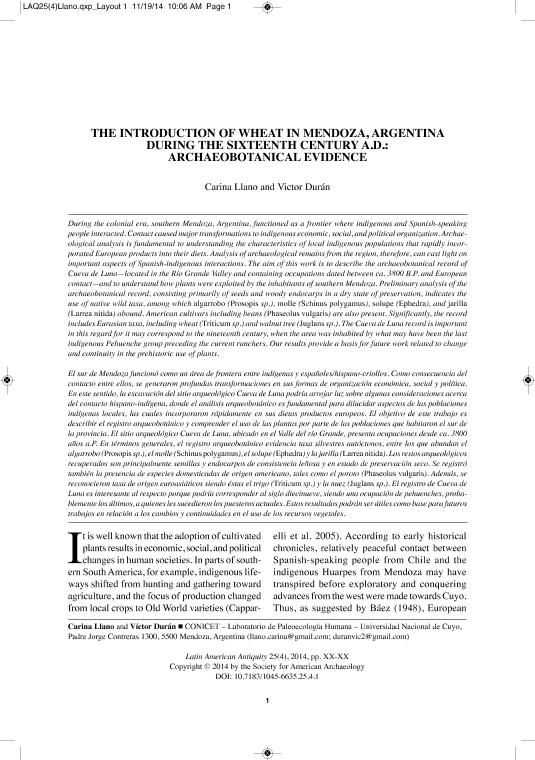Mostrar el registro sencillo del ítem
dc.contributor.author
Llano, Carina Lourdes

dc.contributor.author
Duran, Victor Alberto

dc.date.available
2018-01-19T20:48:05Z
dc.date.issued
2014-12
dc.identifier.citation
Llano, Carina Lourdes; Duran, Victor Alberto; The introduction of Wheat in Mendoza, Argentina during the 16th Century A.D.: archaeobotanical evidence.; Cambridge University Press; Latin American Antiquity; 25; 4; 12-2014; 462-472
dc.identifier.issn
1045-6635
dc.identifier.uri
http://hdl.handle.net/11336/34035
dc.description.abstract
During the colonial era, southern Mendoza, Argentina, functioned as a frontier where indigenous and Spanish-speaking people interacted. Contact caused major transformations to indigenous economic, social, and political organization. Archaeological analysis is fundamental to understanding the characteristics of local indigenous populations that rapidly incorporated European products into their diets. Analysis of archaeological remains from the region, therefore, can cast light on important aspects of Spanish-indigenous interactions. The aim of this work is to describe the archaeobotanical record of Cueva de Luna—located in the Rio Grande Valley and containing occupations dated between ca. 3800 B.P. and European contact—and to understand how plants were exploited by the inhabitants of southern Mendoza. Preliminary analysis of the archaeobotanical record, consisting primarily of seeds and woody endocarps in a dry state of preservation, indicates the use of native wild taxa, among which algarrobo (Prosopis sp.), molle (Schinus polygamus), solupe (Ephedra), and jarilla (Larrea nitida) abound. American cultivars including beans (Phaseolus vulgaris) are also present. Significantly, the record includes Eurasian taxa, including wheat (Triticum sp.) and walnut tree (Juglans sp.). The Cueva de Luna record is important in this regard for it may correspond to the nineteenth century, when the area was inhabited by what may have been the last indigenous Pehuenche group preceding the current ranchers. Our results provide a basis for future work related to change and continuity in the prehistoric use of plants.
dc.format
application/pdf
dc.language.iso
eng
dc.publisher
Cambridge University Press

dc.rights
info:eu-repo/semantics/openAccess
dc.rights.uri
https://creativecommons.org/licenses/by-nc-sa/2.5/ar/
dc.subject
Archaeology
dc.subject
Archaeobotany
dc.subject
Central Western
dc.subject
Argentina
dc.subject.classification
Historia

dc.subject.classification
Historia y Arqueología

dc.subject.classification
HUMANIDADES

dc.title
The introduction of Wheat in Mendoza, Argentina during the 16th Century A.D.: archaeobotanical evidence.
dc.type
info:eu-repo/semantics/article
dc.type
info:ar-repo/semantics/artículo
dc.type
info:eu-repo/semantics/publishedVersion
dc.date.updated
2018-01-17T20:28:49Z
dc.journal.volume
25
dc.journal.number
4
dc.journal.pagination
462-472
dc.journal.pais
Reino Unido

dc.journal.ciudad
Cambridge
dc.description.fil
Fil: Llano, Carina Lourdes. Consejo Nacional de Investigaciones Científicas y Técnicas; Argentina. Universidad Nacional de Cuyo; Argentina
dc.description.fil
Fil: Duran, Victor Alberto. Universidad Nacional de Cuyo; Argentina. Consejo Nacional de Investigaciones Científicas y Técnicas; Argentina
dc.journal.title
Latin American Antiquity
dc.relation.alternativeid
info:eu-repo/semantics/altIdentifier/url/https://www.cambridge.org/core/journals/latin-american-antiquity/article/introduction-of-wheat-in-mendoza-argentina-during-the-sixteenth-century-ad-archaeobotanical-evidence/C3DC9A7AE9572B85CFC7DEDE8CF09380
dc.relation.alternativeid
info:eu-repo/semantics/altIdentifier/doi/https://doi.org/10.7183/1045-6635.25.4.462
Archivos asociados
